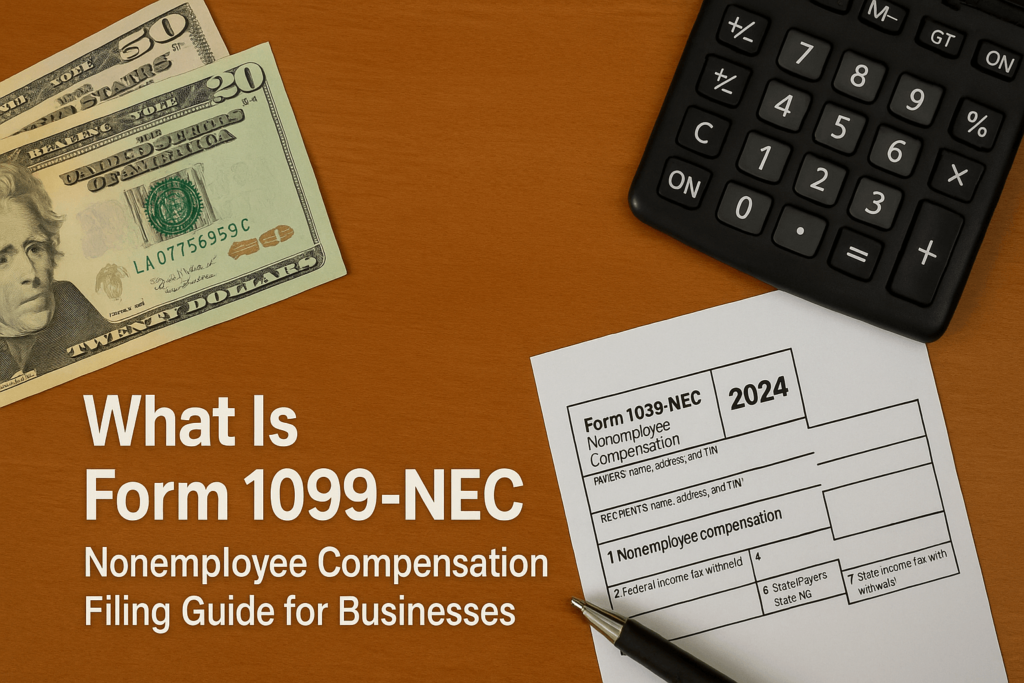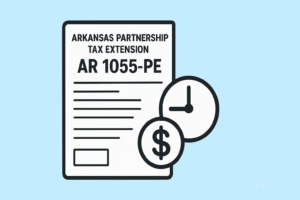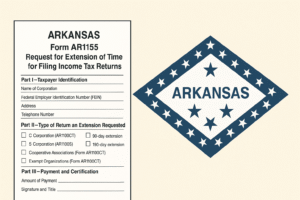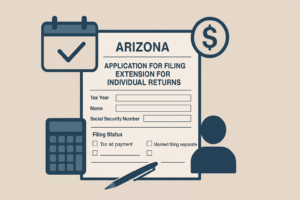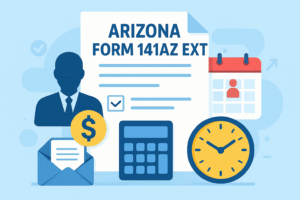If your business hires independent contractors, freelancers, or nonemployees for services, understanding Form 1099-NEC is essential. This IRS form is used to report payments of $600 or more made to nonemployees in the course of business. Whether you’re a small business owner issuing a few forms or managing dozens for a growing team, this guide breaks down everything you need to know—from who must file to how to complete each box correctly.
With strict deadlines and potential penalties for errors or late filing, being informed and prepared is key. In this detailed guide, we’ll cover how Form 1099-NEC differs from Form 1099-MISC, walk through the filing process, explain nonemployee compensation, and show you how to stay compliant and penalty-free.
What Is a 1099-NEC Form?
The IRS Form 1099-NEC, or Nonemployee Compensation, is used to report payments made to individuals who are not employees of your business—typically, independent contractors, freelancers, consultants, or vendors. This form replaced the use of box 7 on the 1099-MISC starting in 2020, creating a distinct form solely for reporting nonemployee compensation.
If you hire someone for services and pay them $600 or more during the year, and they’re not on your payroll, you’ll likely need to file a 1099-NEC.
Who Must File Form 1099-NEC?
Any business or organization (including sole proprietors, partnerships, LLCs, and corporations) that has paid $600 or more to a nonemployee for services in the course of trade or business must file Form 1099-NEC. This includes:
- Freelancers and gig workers
- Attorneys (even if incorporated)
- Consultants
- Contractors for repairs, marketing, or design work
Personal payments (e.g., hiring a nanny or tutor for your home) do not require a 1099-NEC.
Remember: Businesses use Form W-2 for employees and Form 1099-NEC for nonemployees like freelancers or independent contractors.
1099-NEC vs 1099-MISC
While both forms are part of the 1099 series, they serve different purposes:
| Feature | 1099-NEC | 1099-MISC |
| Used For | Nonemployee compensation | Rents, royalties, prizes, legal settlements |
| Filing Deadline | Jan 31 (to IRS and recipient) | Feb 28 (paper) / Mar 31 (e-file) to IRS |
| Who Receives | Independent contractors | Landlords, prize winners, attorneys (non-service fees) |
Remember: Use 1099-NEC for services; use 1099-MISC for non-service-related payments.
What Are the Different Copies of Form 1099-NEC?
Form 1099-NEC has multiple copies for different recipients:
- Copy A – Sent to the IRS
- Copy B – Given to the independent contractor
- Copy C – Kept by the payer (your records)
- Copy 1 – Sent to the state tax department (if applicable)
- Copy 2 – Given to the recipient for their state return (if required)
Always use the official IRS red-ink Copy A for paper filing.
What Is Nonemployee Compensation?
Nonemployee compensation includes payments of $600 or more made to individuals who are not employees but perform services for your business. Examples:
- Fees for graphic design, accounting, or IT support
- Professional services like legal or consulting
- Commission payments to independent salespeople
- Prizes for professional achievements (not personal contests)
Such individuals must also not be on your company payroll.
When Is the Deadline to File 1099-NEC?
Recipient Copy Deadline:
- January 31, 2025 – You must furnish Copy B to the independent contractor.
IRS Filing Deadline:
- January 31, 2025 – Same-day deadline whether filing by paper or electronically.
There are no automatic extensions for the recipient copy. But you may request a filing extension for the IRS copy using Form 8809 or for the recipient copy using Form 15397 (recently introduced).
What’s the Filing Procedure for Form 1099-NEC?
- Collect Form W-9 from the contractor before making any payments.
- Fill out 1099-NEC – Use accurate name, address, and TIN.
- File Copy A with the IRS.
- Paper: Use red-ink forms.
- E-file: Use the IRS FIRE system or an authorized e-file provider.
- Send Copy B to the contractor.
- Keep Copy C for your records.
- Submit state copies, if your state requires it.
How to Complete Form 1099-NEC – Box by Box
| Box | What It Means |
| Box 1 | Total nonemployee compensation paid to the contractor. Must be $600 or more for the year. Include fees, commissions, bonuses. |
| Box 2 | Reserved for future use. Currently not used—leave it blank. |
| Box 3 | Also reserved—leave this blank. |
| Box 4 | Federal income tax withheld, if any (usually under backup withholding). Most businesses leave this blank unless backup withholding applies. |
| Box 5-7 | State information – For reporting state income if required. Box 5: State income, Box 6: State identification number, Box 7: State tax withheld. |
| Payer Info | Your business’s name, address, and TIN. |
| Recipient Info | Contractor’s name, address, and TIN (from W-9). |
Double-check all fields. Errors can lead to penalties.
Pro Tip – IRS Releases Draft of 2025 Form 1099-NEC
The IRS released the draft version of Form 1099-NEC for 2025, which includes a key change: Box 3, previously marked “Reserved,” is now designated for reporting excess golden parachute payments—a field that was formerly part of Form 1099-MISC, Box 14. Be sure to review the final form once released to ensure you’re using the correct version and reporting these amounts accurately if applicable.
How to File 1099-NEC
You have two main methods to file:
1. Paper Filing
- Order physical red-ink forms from the IRS.
- Use Form 1096 as the summary transmittal form.
- Mail to the IRS by January 31, 2025.
2. Electronic Filing
- Use the IRS FIRE system or authorized software.
- Required if filing 10 or more information returns.
Most businesses now prefer e-filing due to convenience and compliance.
What Independent Contractors Do with Form 1099-NEC
If you’re an independent contractor receiving a 1099-NEC:
- Use the form to report income on Schedule C (Form 1040).
- Pay self-employment taxes (Social Security and Medicare) via Schedule SE.
- Keep it for your records—this is not optional income.
If the payer doesn’t issue a 1099-NEC but you were paid, you must still report the income.
What Happens If You Don’t File or Furnish Form 1099-NEC?
Failing to file or furnish 1099-NEC can lead to IRS penalties:
| Action | Penalty per Form (2025) |
| Filed within 30 days late | $60 per form |
| 31 days late – Aug 1 | $120 per form |
| After August 1 or never | $310 per form |
| Intentional disregard | $630+ per form (no maximum cap) |
You may also face backup withholding obligations if no TIN is provided.
Requesting an Extension to File or Furnish 1099-NEC?
- For IRS filing, use Form 8809 to request an automatic 30-day extension.
- For recipient copy, use Form 15397, which allows a non-automatic extension—you must show cause (e.g., natural disaster, serious illness).
Note: The IRS may not grant extensions easily for the recipient copy unless there’s a valid reason.
Critical Dos and Don’ts with Form 1099-NEC
DO:
- Collect a W-9 before payment.
- Verify TINs using the IRS TIN Matching program.
- File on time (January 31).
- Keep accurate records of payments and correspondence.
- Use the correct boxes on the form.
DON’T:
- Don’t report payments under $600 (unless required for other reasons).
- Don’t file electronically without ensuring all data is correct.
- Don’t send the wrong form (like using 1099-MISC instead of NEC).
- Don’t ignore state filing requirements if your state participates in the Combined Federal/State Filing program.
Final Thoughts
Form 1099-NEC is essential for reporting payments to independent contractors and staying compliant with IRS rules. Filing it accurately and on time helps avoid penalties and keeps your business in good standing. Whether you’re issuing or receiving the form, understanding its purpose and details is key. Stay organized, follow deadlines, and consult a tax professional if needed to ensure smooth year-end reporting.

